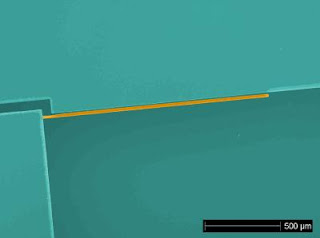Described in a forthcoming issue of Physical Review Letters,* this demonstration of radio-frequency (RF) cooling of a relatively large object may offer a new tool for exploring the elusive boundary where the familiar rules of the everyday, macroscale world give way to the bizarre quantum behavior seen in the smallest particles of matter and light. There may be technology applications as well: the RF circuit could be made small enough to be incorporated on a chip with tiny oscillators, a focus of intensive research for use in sensors to detect, for example, molecular forces.
The NIST experiments used an RF circuit to cool a 200 x 14 x 1,500 micrometer silicon cantilever—a tiny diving board affixed at one end to a chip and similar to the tuning forks used in quartz crystal watches—vibrating at 7,000 cycles per second, its natural “resonant” frequency. Scientists cooled it from room temperature (about 23 degrees C, or 73 degrees F) to -228 C (-379 F). Other research groups have used optical techniques to chill micro-cantilevers to lower temperatures, but the RF technique may be more practical in some cases, because the equipment is smaller and easier to fabricate and integrate into cryogenic systems. By extending the RF method to higher frequencies at cryogenic temperatures, scientists hope eventually to cool a cantilever to its “ground state” near absolute zero (-273 C or -460 F) , where it would be essentially motionless and quantum behavior should emerge.
Laser cooling is akin to using the kinetic energy of millions of ping-pong balls (particles of light) striking a rolling bowling ball (such as an atom) to slow it down. The RF cooling technique, lead author Kenton Brown says, is more like pushing a child on a swing slightly out of synch with its back-and-forth motion to reduce its arc. In the NIST experiments, the cantilever’s mechanical motion is reduced by the force created between two electrically charged plates, one of which is the cantilever, which store energy like electrical capacitors. In the absence of any movement, the force would be stable, but in this case, it is modulated by the cantilever vibrations. The stored energy takes some time to change in response to the cantilever’s movement, and this delay pushes the cantilever slightly out of synch, damping its motion. ###
* K.R. Brown, J. Britton, R.J. Epstein, J. Chiaverini, D. Leibfried, and D.J. Wineland. 2007. Passive cooling of a micromechanical oscillator with a resonant electric circuit. Physical Review Letters. [Forthcoming].
Contact: Laura Ost laura.ost@nist.gov 303-497-4880 National Institute of Standards and Technology (NIST)
Technorati Tags: Nano or Nanotechnology and Nanotech and Radio wave cooling or National Institute of Standards and Technology and ultraviolet laser light or White House Press Briefing by Dana Perino 10/04/07 VIDEO PODCAST and Los Angeles City Hall and Researchers improve ability to write and store information on electronic devices















No comments:
Post a Comment